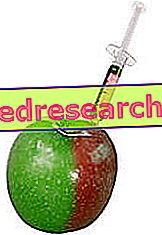Generality
Zucchini flowers and courgette flowers are products of vegetable origin belonging to the VI group of foods. They do not provide a particularly rich or worthy attention to nutrition but, to their advantage, they offer a rather moderate energy content.

The courgette flowers and the courgette flowers are the inflorescence of plants belonging to the Curcubitaceae family and the genus Cucurbita ; Pumpkin Species are very numerous but, in Italy, flowers are predominantly derived from moschata (squash violina) and from maxima . Zucchini flowers, on the other hand, are derived from the Cucurbita pepo species.
Cultivation
Pumpkins and courgettes are plants commonly sown or transplanted at home; compared to the pumpkin, the courgette needs some extra care. It is essential that the soil is well worked, draining, rich in nitrogen and never lacking calcium, phosphorus, potassium; the pumpkin "is satisfied" with a less rich soil but its absorption capacity impoverishes it further. For both, irrigation must be constant and systematic, once a day in the summer months and even two in August; however, water must never wet the leaves or stagnate on the ground. Plant placement is essential; a total solar exposure is required for the pumpkins and almost total for the courgettes (depending on the climate). To avoid contagion from fungi and molds (mainly mildew and downy mildew), it is crucial to guarantee the air circulation and, for the courgette, to maintain a certain distance between the plants. While the courgette grows as a bush and occupies a relative space, the pumpkin, being a climber, expands in an almost infesting manner.
Both the pumpkin and the courgette produce male and female flowers; both have a bright yellow color and from open have a typical "star" shape. The male flowers are recognizable as they stand out, with a long stem, directly from the stem of the plant; their pistil is thin and rich in pollen. The female flowers, on the other hand, are attached to the vertex of the fruit and have a shorter and fleshy pistil; being attached to one another, cutting the flower stops the growth of the fruit, therefore the practice is not recommended until the moment of collection. In the pumpkin it is advisable to consume only the male flowers since the feminine do not reach the end of the ripening of the fruit and, as already said, removing them would compromise the success of the fruitful harvest.
Purchase
In case you want to buy, pumpkin flowers and courgette flowers must have very specific characteristics. Dispelling a commonplace, it is not necessary for the flowers to be open or closed; the shape absolutely does not alter the taste of the food, but predisposes them to some recipes over others. At the time of purchase it is essential that the courgette flowers and the courgette flowers have a bright color in all their nuances and boast a consistency sufficient to maintain their shape.
| Composition for 100g of the courgette flowers - Reference values of the INRAN Food Composition Tables | ||||||||||||||||||||||||||||||||||||||||||||||||||||||||||||||||||||||||||||||||||||||||||||||||||||||||||||||||||||||||||||||||||||||||||||
 | ||||||||||||||||||||||||||||||||||||||||||||||||||||||||||||||||||||||||||||||||||||||||||||||||||||||||||||||||||||||||||||||||||||||||||||
Nutritional values (per 100 g of edible portion)
| ||||||||||||||||||||||||||||||||||||||||||||||||||||||||||||||||||||||||||||||||||||||||||||||||||||||||||||||||||||||||||||||||||||||||||||
Dark flowers at the top of the petals or tendentially mosci should be discarded. Another decisive element is the color of the pistil; this must always be a bright yellow and never brown. Browning is an indicator of infection from fungi and molds.
Preparation and recipes
In addition to washing, the only essential intervention for preparing zucchini and courgette flowers involves the extraction of the pistil; this, if left, can play a good bitter function. Moreover, some use the male flowers totally depriving them of the stem but, personally, I consider it an excellent ornamental characteristic.
The most well-known recipes involving pumpkin and courgette flowers are: "fried pumpkin flowers (battered and / or stuffed)" and "baked stuffed pumpkin flowers". For those fried and battered I suggest using open flowers and a batter of blonde beer and wheat flour ; for those stuffed, depending on the content, the batter can also be produced with milk (eg, if cheese is introduced). Council to fry in peanut oil.
Baked pumpkin flowers require no coating and can be filled with any delicacy: cold cuts, cheeses, ricotta, fish, shellfish, crustaceans, vegetables, etc.
Do not miss the savory pies made with zucchini and courgette flowers; these should be cut, sautéed and then placed in the quiche. Even among the first courses there are many recipes based on pumpkin flowers; among the tastiest we mention the "fresh Tagliatelle with zucchini flowers, shallots, fresh parsley and saffron".
Nutritional characteristics
Pumpkin flowers are low-calorie vegetables, low in carbohydrates, with a negligible portion of lipids and with just over a gram and a half of protein per 100g of edible portion. The fiber is not mentioned in the table.
As far as mineral salts are concerned, it overwhelms the iron content (obviously, compared to the food group to which it belongs), but disappoint others. With regard to vitamins, the content of carotenoids (retinol equivalent - vit. A) is decidedly appreciable, to which we owe the yellow color of the courgette and courgette flowers.
Pumpkin Stuffed Baked flowers
X Problems with video playback? Reload from YouTube Go to Video Page Go to Video Recipes Section Watch the video on youtube



